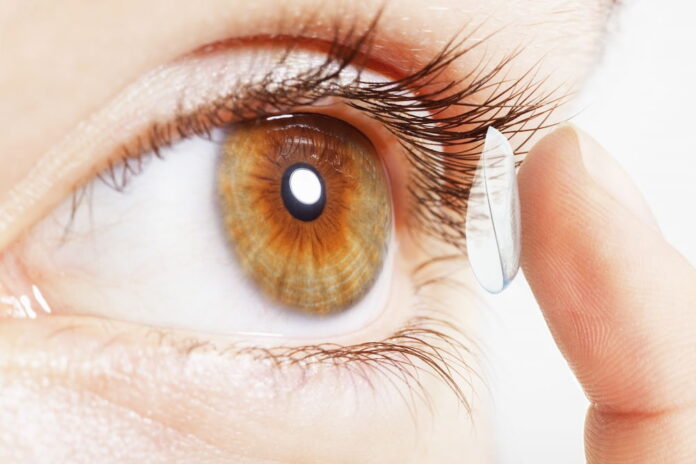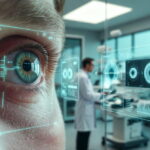Multifocal contact lenses are designed to provide people with presbyopia, a condition that typically develops in middle age, with clear vision at multiple distances without the need for reading glasses. These lenses combine different prescriptions into a single lens, allowing wearers to see near and far distances. Let’s talk more about how multifocal lenses work:
Presbyopia occurs when the lens in the eye stops changing shape, making it difficult to focus on objects up close. Traditionally, the solution to this problem has been to wear reading glasses or bifocal glasses, which contain two prescriptions in the same lens. However, many people find glasses uncomfortable or inconvenient, and they may prefer contact lenses as an alternative.
Multifocal contact lenses, like bifocal glasses, contain two or more prescriptions in the same lens. However, unlike bifocal glasses with a visible line separating the different prescriptions, multifocal contact lenses gradually transition from one prescription to another. It allows the wearer to see clearly at different distances without needing different lenses or glasses, you can check the latest multifocal contact lenses offers from contactlenses4us
Types of multifocal contact lenses:
There are two types of multifocal contact lenses: simultaneous vision lenses and segmented lenses.
Simultaneous vision lenses, also known as concentric or center-near lenses, provide both near and far vision in the same area of the lens. The lens is designed with alternating rings of distance and near prescription, allowing the wearer to focus on objects at different distances by simply shifting their gaze.
This design is similar to the way the natural lens in the eye works, with different areas of the lens responsible for focusing on different distances.
Segmented lenses, also known as translating or alternating lenses, have two distinct areas of the lens with different prescriptions. The top of the lens is designed for distance vision, while the bottom is designed for near vision.
When the wearer looks straight ahead, the lens sits on the lower lid, and the distance prescription is in use. When the wearer looks down to read, the lens moves up, and the near prescription comes into focus. This movement is called lens translation and occurs naturally as the eye blinks and moves. Are you still confused about how to put in contacts? Read it!
Several factors must be considered when fitting a patient for multifocal contact lenses. The patient’s age, prescription, and visual needs will all play a role in determining the appropriate lens design.
The curvature of the cornea, the pupil’s size, and the lens’s position on the eye will also be considered to ensure a proper fit.
In addition to providing clear vision at multiple distances, multifocal contact lenses offer several other benefits. For example, they can provide a wider field of vision compared to traditional reading glasses or bifocals, as wearers do not need to look through different lens parts for different distances.
Multifocal contact lenses can also provide a more natural appearance than glasses, particularly for people who do not want the visible line of bifocal glasses.
Conclusion
Multifocal contact lenses combine different prescriptions into a single lens, allowing wearers to see near and far distances without needing reading glasses or bifocals. If you find issues with seeing things normally, then contact your doctor and find out.
Read Also
- Ketamine-Assisted Therapies: Impacts on Employee WellbeingWorkplace stress is common today. Many employees feel tired, anxious, or burned out. Regular therapy can help, but some people need more support. Ketamine-assisted therapy is showing good results for mental health. A ketamine-assisted therapist guides each session safely. This therapy can improve mood, focus, and energy. Learning more about it can help teams stay… Read more: Ketamine-Assisted Therapies: Impacts on Employee Wellbeing
- The Future of Men’s Health: Why Telehealth Is Here to StayTelehealth isn’t just a pandemic trend that faded into the background. For Australian men, it has become one of the most practical, time-saving, and stress-free ways to manage everyday health — and it’s shaping the future of how we access care. Platforms like DOCTO, an Australian online doctor and specialist telehealth service, are leading the… Read more: The Future of Men’s Health: Why Telehealth Is Here to Stay
- How to Build a Simple, Clean Skincare Routine ?You don’t need a complicated skincare routine. It doesn’t have to be something that requires twenty different products and confusing steps. Your routine works well with just a few high-quality clean ingredients. The beauty industry keeps pushing more products, but your skin actually needs less. You only need a simple approach to get better results… Read more: How to Build a Simple, Clean Skincare Routine ?
- How Preventive Dental Care Supports Overall HealthHave you ever wondered how a simple dental checkup could impact your entire body? Oral health is more than just a bright smile. Studies show that poor dental habits can contribute to serious health problems. Gum disease and tooth decay are linked to heart disease, diabetes, and infections. Yet, many people overlook preventive dental care.… Read more: How Preventive Dental Care Supports Overall Health
- Seeing Clearly in a High-Tech World: A Deep Dive into Advanced Vision Care ServicesProtecting your eyesight isn’t optional—it’s essential. Modern eye care has evolved far beyond basic exams, offering advanced diagnostics, personalized treatments, and surgical innovations that keep vision sharp for life. A leading example is Intermountain Eye Center, home to specialists like Dr Fishburn Boise, where patients receive comprehensive, high-level vision care designed to preserve long-term eye… Read more: Seeing Clearly in a High-Tech World: A Deep Dive into Advanced Vision Care Services






